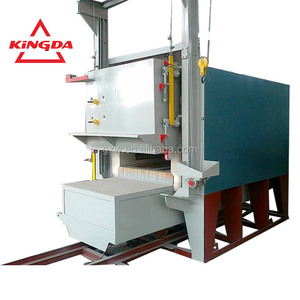
All categories
Featured selections
Trade Assurance
Buyer Central
Help Center
Get the app
Become a supplier

(6829 products available)




















Generally, blast furnaces are vertical, closed, cylindrical industrial reactors that use chemical reactions to extract valuable minerals from ores. In the steel industry, it refers primarily to the enormous cylindrical steel towers that extract iron from iron ore using coking coal as fuel. Although the design of blast furnaces for extracting iron and other metals like copper and zinc is similar, the technology and methods differ significantly for each metal.
Iron blast furnace:
The traditional iron making in the blast furnace is a complex process in which iron ore, cokes and limestone are used to produce molten iron and slag. The modern blast furnaces are enormous reactors up to 7 meters wide and 25 meters high. They can produce gigantic amounts of cast iron every day. The iron is then used in the steel industry or in foundries to manufacture cast iron products. The coke is burned in the lower part of the furnace - the raceway - to produce hot gasses, carbon dioxide and carbon monoxide, which react with water and silica in the limestone to become carbonates. The intense heat in the lower section of the blast furnace - around 1300-1500 °C - causes the iron ore to lose oxygen and turn into molten iron, which is also called pig iron. The limestone serves as a flux to remove impurities like phosphorous, sulfur, silica, and alumina, which combine with the slag and float on the surface of the molten iron. The slag is lighter than molten iron and can be easily separated. About 3000 to 10000 cubic meters of hot air are injected from the bottom of the furnace every minute to keep the chemical reactions going and to burn the coke more efficiently. This technique is known as "top downward and high-speed air-combustion."
Blast furnace for copper:
In the copper industry, the blast furnace is used to extract copper from copper sulfide ores and recycling materials. The process begins by crushing and grinding copper ore. Then the ore is heated in a smelting furnace together with fluxes and reducing agents like natural gas or charcoal to produce copper matte, which contains copper sulfide. In some countries electric arc furnaces are preferred over blast furnaces for copper extraction. The copper matte can then be further refined in converters or electric furnaces to produce copper metal, which is used in a variety of applications including electrical wiring, plumbing and electronics. About 1.5 metric tons of CO2 are emitted for each ton of primary copper produced according to some studies. Around 4500 cubic meters of air are injected into the copper blast furnace every hour to help burn the fuels more efficiently and increase the speed of combustion.
Blast furnace for zinc:
The mechanism used in zinc production is also different from that of iron or copper. Zinc is usually found in sphalerite ore deposits together with other metals like lead and copper. The zinc blast furnace is also called a "retort" because it heats zinc ore, usually sphalerite, at very high temperatures in a vertical cylindrical apparatus. The ore is reduced using carbon in the form of biochar, coal, or natural gas in the presence of oxygen and lime. The reaction produces zinc fumes that are cooled down and precipitated as zinc oxide powder. Zinc production has a much lower carbon footprint than iron or copper production. Only about 0.57 metric tons of CO2 are produced for each ton of zinc refined from ore. Additionally, around 4.5 tons of CO2 are emitted when recycling zinc from end-of-life consumer products.
The specifications of the blast furnace differ depending on whether it is a small-scale or large-scale furnace. The small-scale furnace is about 6-9m tall. On the other hand, large-scale blast furnaces can be as tall as 140m. The diameter of the blast furnace also varies. The smaller ones have a diameter of about 5m, whereas bigger ones have a diameter of about 10-3m.
Other specifications that may differ include the volume and the production capacity. For example, one small-scale furnace operating at a temperature of 1000-1200 degrees Celsius can produce 0.1-0.2 million tonnes of iron per year. A larger blast furnace with a volume of 1,000 m3 has the capacity of producing 700,000 tonnes of hot metal per year. The larger ones are often used in integrated steelworks.
The maintenance of a blast furnace is important in order for it to stay in good condition and operate optimally. Following the right maintenance practices can help avoid costly downtimes from repairs.
The primary application scenario of a blast furnace is in iron-making industries. Based on reports, about 70% of the world's ductile iron is made through the blast-furnace process. Industries that primarily use ferrous materials, such as carbon steel, usually employ blast furnaces.
Some of the main application scenarios of a blast furnace include the following:
For the buyers of iron blast furnaces, there are many factors to consider when making an ultimate choice. Some of them include:
Q1: Why is it called a blast furnace?
A1: The name of the furnace is based on the way iron ore is processed. Air is blasted or pumped into the furnace to stimulate the combustion of coke.
Q2: What materials can be recycled in a blast furnace?
A2: Besides producing pig iron, the blast furnace also generates by-products, such as blast furnace slag, which can be recycled on a large scale in the construction sector, including civil and cement and concrete industries.
Q3: What is the difference between a blast and cupola furnace?
A3: A blast furnace is used to produce cast iron, which is then used to manufacture steel. On the other hand, a cupola furnace is employed to produce cast iron directly.